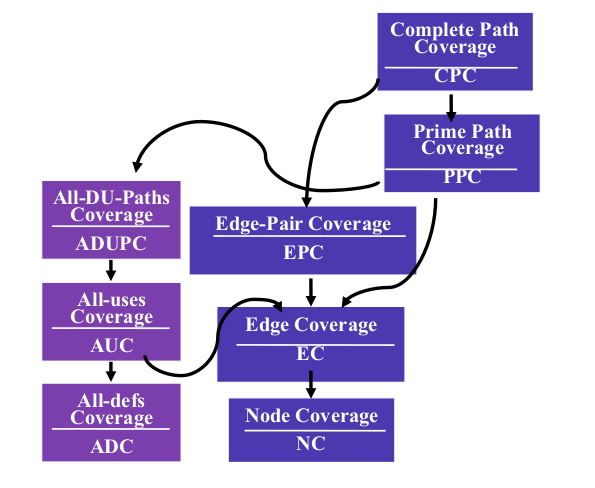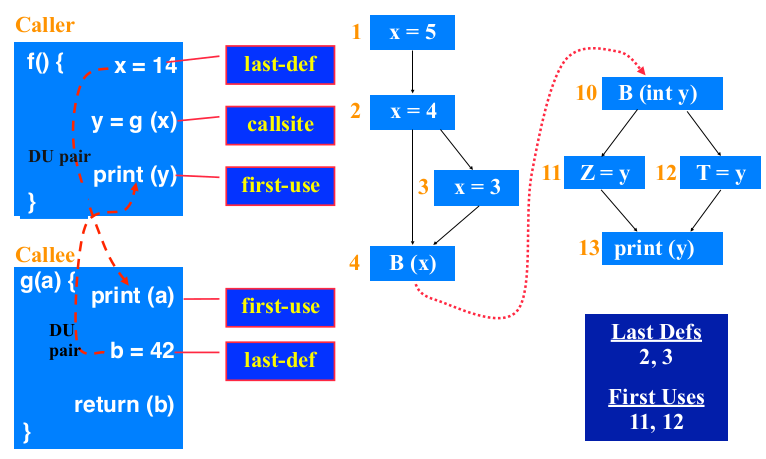Data Flow
Data Flow Criteria
Definition(def) - a location where a value for a variable is stored into memory
Use - a location where a variable's value is accessed
def(n) or def(e) - The sets of variables that are defined by node n or edge e
use(n) or use(e) - The set of variables that are used by node n or edge e

- Node n1 reaches n2 if there is a path in between the two
DU pair - a pair of locations such that a variable that is defined at and used at
// Example
x = 5; // def(x)
...
print(x) // use(x)
Def-clear - a path from to is def-clear with respect to variable if for every node and every edge on from to , where and , is not in def() or in def().
- The variable is not declared in the path
Reach - if there is a def-clear path from to with respect to , the def of at reaches the use at .
DU-path - a simple path that is def-clear with respect to from a def of to a use of
- Associated with a variable
- Simple
- May be any numbe rof uses in a du-path
Def-pair set - - the set of du-paths from to
Def-path set - - the set of du-paths that start at
Coverages
- Assume every def reaches a use
All-Defs Coverage (ADC) - For each set of du-paths , TR
contains at least one path in
- Contains one path from all instances of definition
All-Uses Coverage (AUC) - For each set of du-paths to uses , TR contains at least one path in
- Contains one path from all instances of definition to usage
All-du-Paths Coverage (ADUPC) - For each set , TR contains every path in
- Contains every path from all instances of definition to usage
- Even if they are subpaths of one another
Touring DU-Paths
A test path du-tours subpath with respect to if tours and the subpath taken is def-clear with respect to
Side trips can be used
Best effort touring
- Use every def
- Get to every use
- Follow all du-paths
Definitions and Uses
Definitions
- Direct assignment:
x=5 - Implicit definition:
foo(T x){...} - C++ reference param:
bar(x)
Uses
- x is used when it occurs in an expression that the program evaluates
Basic Blocks
- Can be used to rule out some def and uses as irrelevant
Defs
- Consider the last definition of a variable in a basic block
- If we are not sure whether x and y are aliased keep both of them
Uses
- Consider only uses that aren't dominated by a definition of the same variable in the same basic block
// Not interesting y = 5; use(y);
Graph Coverage Criteria Subsumption

AUC & EC
- For every node with multiple outgoing edges, at least one variable is used on each out edge
The same variables are used on each out edge
Assume test set T satisfies AUC
- Each edge e1 must be either a branch edge or not
- If e1 is a branch edge, then it has a use, thus it must be covered by T
- If e1 is not a branch edge, the closest branch edge before e1, denoted as e2, should be covered by T, and if e2 is covered by a test, e1 must also be; If the closed branch edge doesn't exit, then the program has no branch edges. Therefore e1 must be covered by T
Interprocedural Data Flow
- When values are passed they change "names"
Caller - a unit that invokes another unit
Callee - the unit that is called
Callsite - statement or node where the call appears
Actual parameter - variable in the caller
Formal parameter - variable in the callee

Interprocedural DU Pairs
- In integration testing, we only care about the interface
- We just need to consider the last definitions of variables before calls and returns first uses inside units after calls
Last-def - the set of nodes that define a variable x and has a def-clear path from the node through a callsite to a use in the other unit
- Can be from a caller to callee (param or shared variable)
- Can be from a callee to caller (return variable)
First-use - the set of nodes that have uses of a variable y and for which there is a def-clear and use-clear path from the call site to the nodes
